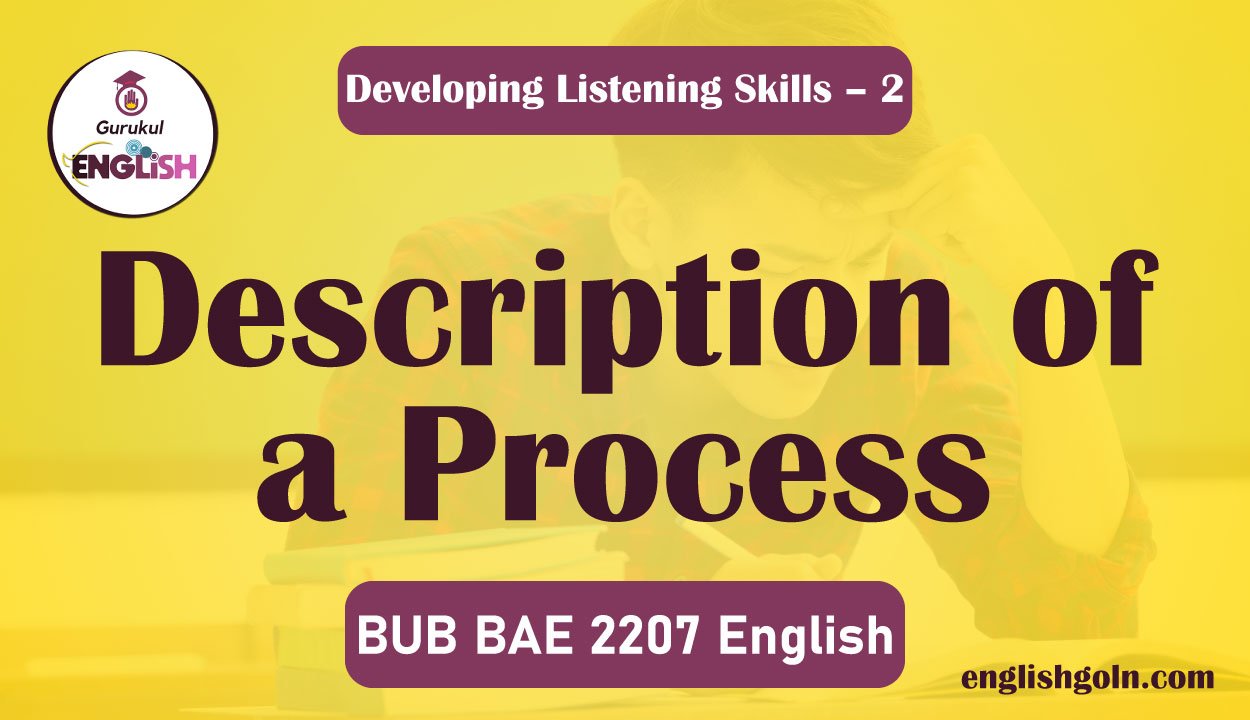Today our topic of discussion is-Description of a Process
Description of a Process
This lesson will focus on the language of describing a process.
Objectives:
After completing this lesson you will be able to: follow the description of how a thing is done. describe a recipe. explain the process of producing something.
Situation :
Conversation between Nipa and Runa about making a drink.
List of Vocabulary and Language Points:
Milk, chop, blender, half a pint, banana, whip, sugar, pour out, cocoa powder. Nipa has come to Runa’s house. She looks very tired. Runa asks her if she would like to have a drink. Nipa answers in the positive and describes the process of preparing the milk shake she wishes to have while Ruma follows her instruction.

Dialogue:
Runa: Hello Nipa. How nice to see you. Come in please.
Nipa: Hello Runa.
Runa:You look very tired.
Nipa O, I am.
Runa :Would you like a drink?
Nipa : Oh. I’d love one. What have you got?
Runa: Oh, anything you like, you tell me. Mm. Well, What I’d like is a banana milk shake. Nipa
Runa:All you need is a banana, some milk, some sugar and if a little cocoa powder can be added,
Nipa: well, that will be extremely delicious.
Runa: I’ve got all of them! O no, the cocoa powder has just been finished yesterday. I need to buy it.
Nipa: That’s ok.. Don’t worry. Have you got a blender? Yes. What should I do first?
Runa: No problem. You just tell me what to do and I’ll make it for you.
Nipa: You chop the banana into the blender.
Runa: There you are.
Nipa Add in half a pint of milk.:
Runa: Half a pint …. ok.
Nipa And then you just put in two small spoons of sugar.
Runa : One and two.
Nipa: There you are. Just whip that up.
Runa: Right, Mm —– its ready. I’ll pour it out for you.
Nipa : That’s great.
Review Questions:
Circle the ingredients used in making the drink.
- cream
- milk
- butter egg orange juice
- cocoa-powder
- water
- tea
- ice cubes
- banana
- sugar
Situation :
A Solar Pond
List of Vocabulary and Language Points:
solar cooker, transported, absorb, solar pond, surface, liner, sunlight, concentration, plastic, energy, zone, rubber, meal, solution, layer, connecting, heat, depth, storage. Mr. Khan is describing to his son, Pasha, the system of a solar pond.
Dialogue:
Pasha :Are you talking about the solar cooker dad?
Mr. Khan:No, I’m talking about a solar pond. You know that sunlight is a kind of energy. You see, by utilizing this energy you can cook your meal even at night or on a cloudy day.
Pasha : That’s really interesting. But dad tell me in detail how this pond can be made?
Mr. Khan: You see, a solar pond has three layers. The top layer consisting of fresh water is only 0.30 metre deep. In this zone heat can be transported from above to downwards. This layer is called the “surface convicting layer”. The next layer is called the “non convecting layer.” This is 1.00 metre deep. This zone contains salt solution.
The salt concentration at this layer increases with the depth, from 1% to 17%. The bottom layer is 1.70 metre deep. It is called the “Storage Zone”, which contains most salt. Sunlight falling on the pond can heat the salt solution at the bottom to a temperature of 100°c, or even more. The heat absorbed from the sun is trapped in the bottom layer. A solar pond needs a liner made of plastic or rubber which prevents leakage of water.
Pasha:This is all very interesting dad.
Mr. Khan:I ndeed.

Review Questions :
Fill in the blanks while you listen to the conversation between Mr. Khan and Pasha.
Pasha: Are you talking about the…… cooker dad?
Mr. Khan: No, I’m talking about a ….pond. You know, that is a kind of _____. You see, by utilizing this you can cook your meals at or even on a
Pasha :That’s really interesting. But dad, tell me in detail how this pond can be……..
Mr. Khan: You see a solar ……….pond has layers. The consisting of water is only …..metre deep. In this zone ……can be transported from above to …..This layer is called the “Surface convicting layer”. The next layer is called the “Non convicting layer”.
This ……is metre This zone contains solution. The salt Zone”, which contains most called the ” falling on the pond can the salt solution at the bottom to a temperature of or even more. The heat absorbed from the sun is in the bottom layer. A solar pond needs a made of plastic orconcentration at this layer increases with the from 1% to The layer is metre deep. It iswhich prevents leakage of
Pasha:This is all very interesting dad.
Mr. Khan: Indeed.
Situation
List of Vocabulary and Language Points:
staple, plough, plenty, chief, manure, moist, harrow, obtain, transplantation, nursery, husk, harvest, straw, tread, cultivation, parboiled.
The speaker:
Rice is our staple food. Bangladesh grows rice in plenty. About two-thirds of the world population have rice it as their chief food. It grows best in hot and moist climate. Bangladesh, India, Srilanka, Burma, Malaysia, Indonesia, Thailand, Egypt, Canada, China and the USA are the rice producing countries.
Rice is obtained from paddy. Paddy without husk is called rice.
The process of rice cultivation is not easy. After the land is ploughed, manured and harrowed, seeds are sown. Plants come out like green grass.
In case of transplantation, the seedlings are sown in a nursery and then transplanted to the field.
In about three months the grown up plants become full of paddy. When the paddy ripens it becomes yellow. Paddy is harvested when it is ripe.
Rice plants with ripe paddy are taken home in bundles. After harvesting, paddy is separated from the straw by beating or treading. At home, paddy is dried in the sun and husked to obtain ‘atop’ rice. When paddy is dried and husked after boiling, it is called ‘parboiled rice.’
Review Questions :
Fill in the blanks.
1. Rice is our …..food.
2.. About …..of the world population have rice as their chief
3.It grows best …in and….. climate.
4. Bangladesh, China, and the…. Burma, Malaysia….., Egypt, are the rice producing countries.
5. Paddy without…… is called rice.
6.After the land is ploughed….. and seeds ….are
7. In case of transplantation, the …..are sown in a transplanted to the field. and then
8. In about…….. months the grown up plants become full of
9. When the paddy..
10.i……t becomes After harvesting paddy is separated from the by beating or
11. At home, paddy is….. in the sun and to obtain ‘atop’ rice.
12. When paddy is dried and husked after……
it is called rice….

List of Vocabulary and Language Points:
Milk, banana, sugar
Situation :
Review and Test
Pasha : solar.
Mr. Khan : solar/sunlight/energy/energy/night / cloudy day.
Pasha:made
Mr. Khan: three/top/layer/fresh/0.30/heat/downwards / 1.00 /deep / salt/depth/ 17% / bottom/1.70/storage/salt /sunlight/heat/100°c/trapped/liner/rubber/water.
Situation :
Review and Test
1. staple 2. two-thirds/food 3. hot/moist 4. India / Srilanka / Indonesia/ Thailand / Canada / USA 5. husk 6. manured/harrowed / sown 7. seedling / nursery 8. three / paddy 9. ripens / yellow 10. straw / treading 11. dried/husked 12. boiling/parboiled.
